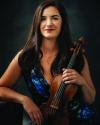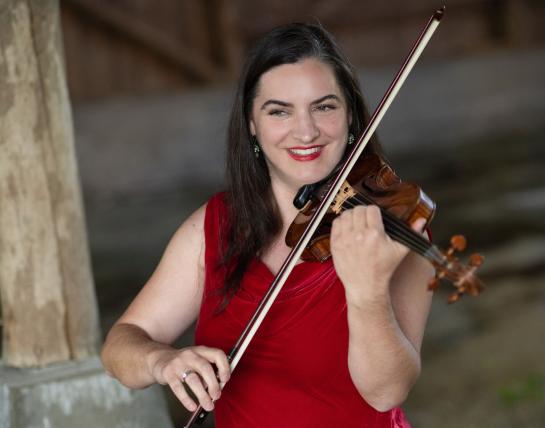Artist-in-residence Tekla Cunningham presents "Bach in Motion," a recital combining music for solo baroque violin with the choreography of Anna Mansbridge. This collaboration between the School of Music and the newly minted Seattle Bach Festival includes music by Telemann, de Visèe, Merula, and a newly commissioned work by Melia Watras, as well as Bach’s iconic Caisson as embodied by dancers Tshedzom Tingkhye and Alejandro Frederickson in new choreography by Mansbridge.
Program
Bach in Motion
Fantasia in E flat major for solo violin, TWV 40:20: Georg Phillip Telemann (1681-1767)
Prelude, Logistille, Chaconne des Harlequins: Robert de Visèe (1652-1730)
Recitative e danza for solo violin: Melia Watras
Foll’è ben che si crede: Tarquinio Merula (1595 -1665)
Partita in d minor for solo violin, BWV 1004: J.S. Bach (1685-1750)
Tekla Cunningham, baroque violin
John Lenti, theorbo
Tshedzom Tingkhye, dancer
Alejandro Frederickson, dancer
Anna Mansbridge: Choreography, in collaboration with the dancers
Andrew Smith, lighting designer
Program Notes
by Tekla Cunningham (TC) and John Lenti (JL)
Telemann’s fantasias for solo violin were published n 1735, about 15 years after JS Bach’s more extravagantly conceived Sonatas and Partitas. Bach and Telemann enjoyed a warm personal and professional friendship (Telemann was godfather to Bach’s son Carl Philipp Emmanuel). The Fantasias are simpler and shorter than Bach’s solo pieces for violin, and overflow with the Telemann’s trademark melodic grace, charm and humor. The Fantasia in E flat major begins with a simple conversation between a descending scale in the bass and a simple dolce melody in the upper register. A spirited Allegro is followed by a brooding Largo. The final Presto is winking, scurrying and playful by turn. (TC)
Robert de Visée was a musician in the court of Louis XIV who numbered among his many duties playing the monarch to sleep on occasion. De Visée’s arrangements of popular orchestral numbers from Lully’s operas would have been golden oldies by the time he was playing them for the aging Sun King. “Logistille” is a lullaby that becalms titular hero of Lully’s Roland, and while the “Chaconne des Harlequins” is a grotesque clown dance in the farcical ballet Le Bourgeois Gentilhomme, it sounds kind of sweet on the theorbo. (JL)
Melia Watras’ piece Recitativo e danza was commissioned for this program. Inspired by baroque forms, the Recitative is a prayerful mediation. The danza evolves from vigorous and sturdy beginning to whirling, circling crescendo of energy and movement. (TC)
Tarquinio Merula’s “Foll’è ben” is one of humanity’s perfect love songs and it makes a charming instrumental corrente. Its first stanza is roughly “He’s good and crazy if he thinks he can use flattery or threats to make me walk away from my baby; my imprisoned heart doesn’t want to break free, all y’all go on and talk all you want.” (JL)
Bach’s D minor partita comprised of 4 dance movements crowned by an extended Ciaccona. The opening Allemanda is a philosophical and ambling piece, followed by a muscular Italian-style Corrente. The Sarabanda is one of the most lonely, piercing and reflective of Bach’s solo movements, and contrasts with the sprightly dance of the Giga that follows. Written after the death of his first wife, the Ciaconna unfolds in variations on the same bass pattern. From the grand opening statement, the opening section in d minor flows through a seemly inexhaustible range of elaborations on the theme, some simple and tender, some with more propulsive and driving energy. Swirls of scales ascend and break into an extended arpeggio section that seems to be a kind of spiritual outcry, followed by a return of the stately opening theme and a turn to D major. This section begins prayerfully and simply, and the music is radiant, peaceful, hopeful. An ecstatic energy develops as it reaches ever higher in register. A second arpeggiated section, this time in the major, is a bridge to the final section of the piece, which returns to d minor. After the preceding emotional storms and moments of light and hope, this concluding section is a poignant exhalation and return to melancholy. The variations here are more subdued than in the opening section, and when the opening Ciaccona theme returns at the very end, there is a sense of having returned home after an arduous journey. A bit battered, a bit weary, but with a satisfying sense of completing the circle.
Biography

Tekla Cunningham, baroque violin, viola and viola d'amore, enjoys a varied and active musical life. At home in Seattle, she is concertmaster of Stephen Stubbs' Pacific MusicWorks, principal second violin with Seattle Baroque Orchestra & Soloists, and plays regularly as concertmaster and principal player with the American Bach Soloists in California. She directs the Whidbey Island Music Festival, a summer concert series presenting vibrant period-instrument performances of repertoire ranging from Monteverdi to Beethoven.
She has appeared as concertmaster/leader or soloist with the American Bach Soloists, Baroque Chamber Orchestra of Colorado, Seattle Baroque Orchestra, and Musica Angelica (Los Angeles). She has also played with Apollo’s Fire, Los Angeles Opera, Philharmonia Baroque Orchestra, and at the Carmel Bach Festival, San Luis Obispo Mozart Festival, Indianapolis Early Music Festival, Savannah Music Festival and the Bloomington Early Music Festival. She has worked with many leading directors including Rinaldo Alessandrini, Giovanni Antonini, Harry Bicket, Paul Goodwin, Martin Haselböck, Monica Huggett, Nic McGegan, Rachel Podger, Jordi Savall, Stephen Stubbs, Jeffrey Thomas, Elizabeth Wallfisch and Bruno Weil.
An avid chamber musician, Tekla enjoys exploring the string quartet repertoire of the 18th and early 19th century with the period-instrument Novello Quartet, whose abiding interest is the music of Haydn. She is also a member of La Monica, an ensemble dedicated to music of the 17th century, whose concerts have been reviewed as “sizzling”, and praised for their “irrepressible energy and pitch-perfect timing”. With Jillon Dupree, harpsichord, and Vicki Boeckman, recorders, she plays in Ensemble Electra, known for its inventive programs and energetic performances.
She can be heard on recordings with the American Bach Soloists, Apollo’s Fire, Philharmonia Baroque Orchestra, Tafelmusik, Seattle Baroque Orchestra, San Francisco Bach Choir, various movie soundtracks including Disney’s Casanova, La Monica’s recent release The Amorous Lyre, a recording of repertoire of Merula and his contemporaries and the Novello Quartet’s recording of Haydn’s Op. 50 string quartets. This summer she recorded Mozart’s Flute Quartets with Janet See, Laurie Wells and Tanya Tomkins.
Tekla received her musical training at Johns Hopkins University and Peabody Conservatory (where she studied History and German Literature in addition to violin), Hochschule für Musik und Darstellende Kunst, in Vienna, Austria, and at the San Francisco Conservatory of Music, where she completed a Master’s degree with Ian Swenson. She teaches Suzuki violin in both German and English and is on the early music faculty of Cornish College for the Arts.
